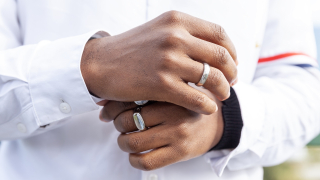Earlier this week, the family of the late musical legend Marvin Gaye was once again in the news when they won a settlement from EMI Records, concerning Robin Thicke’s popular summer anthem, “Blurred Lines,” jacking the groove Gaye’s classic 1976 single, “Got to Give It Up.” While the settlement doesn’t let the blue-eyed soul man, or producer Pharrell Williams, off the Motown hook for supposedly infringing their copyrights, it does release the publishers from anymore litigation.
Back in the summertime, when I was staying in Harlem and hearing “Blurred Lines” on a regular, the Internet started to buzz about the similarities between the two jams. My first thought was, if nothing else, at least a new generation of listeners would be turned on the musical magic that was Marvin.
In my mind, I imagined teenagers gathered around whatever device they stream songs from head-nodding to “Got to Give It Up,” absorbing the lessons of “What’s Going On” or digging the divorce-inspired lyricism of “When Did You Stop Loving Me, When Did I Stop Loving You.” Any fool can write a song about love, but it takes a real artist to make a double-album (Here, My Dear) about the breakup.
Though I grew up a child of the Motown era—watching the Supremes on various variety shows, wishing the Jackson 5 were members of my own family, standing in front of the radio as WWRL blared—it wasn’t until the ripe old age of 10 when I was first made aware of the singer whose voice would become number one in my personal soul canon for the next 40 years.
Of course, Curtis Mayfield, Stevie Wonder, Sly Stone and Gaye’s lover man rival Teddy Pendergrass (who once dated Gaye’s second ex-wife, Jan) will always be in the top 10 of my throwback jukebox. But there’s something about Marvin’s haunting voice that keeps me coming back for more. Be it the truthfulness of his lyrics on What’s Going On and Here, My Dear, the sensuality of his delivery on Let’s Get It On, or the gritty elegance of his tone on his duets with Tammi Terrell, every time I listen to a Marvin Gaye joint, I feel as though I learned, felt and experienced something fresh.
While folks older than myself could tell you all about “Hitch Hike” or any of Gaye’s clean-cut works from the 1960s, I much prefer the scruffy Marvin of the 1970s. The coke sniffing, IRS-hounded “trouble man” who talked about the craziness of the world one year (What’s Going On, 1971) and the next released a brilliant soundtrack to a crappy movie (Trouble Man, 1972).
Still, it wasn’t until the following year that the brother put a mojo on me with one of the nastiest songs of the era. Released in June of 1973, Gaye’s seven-inch single of “Let’s Get It On” served as both my introduction to Marvin’s voice as well as a peep into a lustful landscape of carnal knowledge beneath a red light bulb.
Taken to an adult party in Pittsburgh by my Aunt Ricky and Uncle Ed, I clearly recall wandering throughout the house checking out the various scenes. On one floor, my little brother and the host’s son were jumping (literally) out of the second-floor window, while outside my cousin Deenee was making out with some dude in an Army uniform.
Drifting towards the living room where the grown folks were dancing, I stood in the doorway and simply watched. As though on cue, somebody clumsily dropped the needle on the record and, as the opening wah-wah guitar gently dragged them into the song, the couples jumped from their seats and held each other tight as Gaye sang, “I’ve been really tryin’, baby/Tryin’ to hold back these feelings for so long.”
For the next three minutes and 58 seconds, as the dancing became raunchy and raw, I stood wide-eyed and took it all in: the animalistic movements of some, the way one woman puckered her lips, the way another flicked her hair, the way the men slid closer and closer. There was some love and lots of lust in that room.
It was summertime, and some people were sweating, but even if it had been below zero, more than a few would’ve been perspiring. The moment the song reached its climax, somebody screamed “Put it on again!,” and for the next half-hour, as “Let’s Get It On” played continuously, I not only got schooled in sexual liberation ’70s style, but also became a Marvin Gaye fan for life.
Years later, neo-soul pioneer and Marvin Gaye aficionado D’Angelo told me, “One of the reasons I like Marvin Gaye so much [is] he didn’t give a damn. He just said whatever the [expletive deleted] he wanted to say. But he did it so dope people had to appreciate it. He was an artist, a true artist.” I couldn’t agree more.
Cultural critic Michael A. Gonzales has written cover stories for Vibe, Uptown, Essence, XXL, Wax Poetics and elsewhere. He’s also written for New York and The Village Voice. Read him at Blackadelic Pop and follow him on Twitter @gonzomike.













